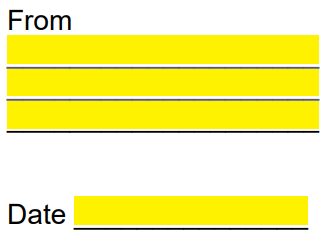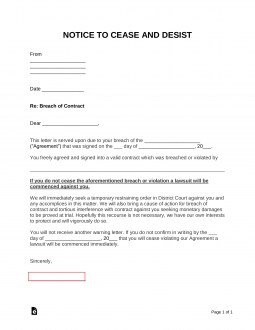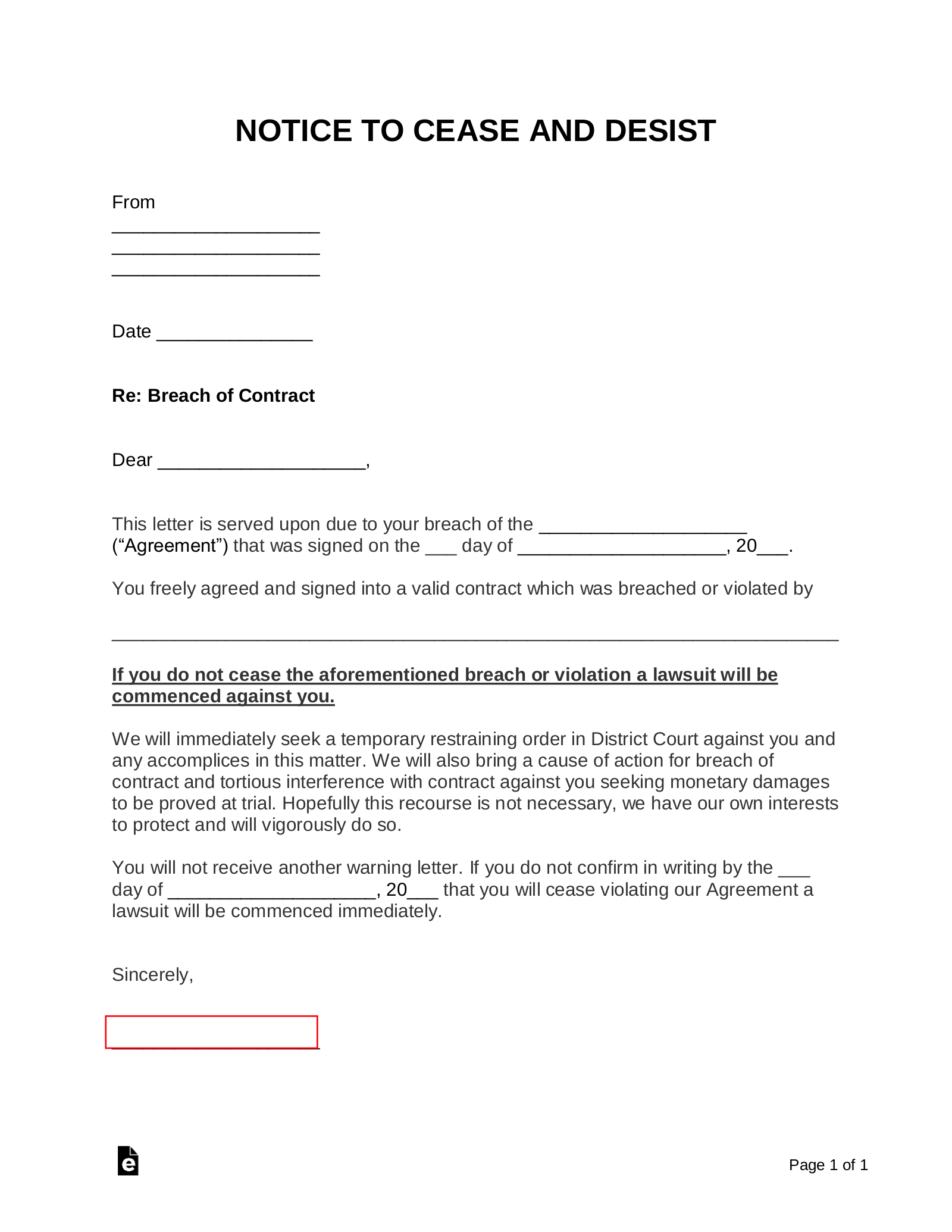Updated June 23, 2023
A breach of contract cease and desist letter is sent to a party that has entered into an agreement and has violated the terms resulting in damages to the claimant. This letter is commonly used when the defendant is in violation of an employment or non-compete agreement. Often utilized as a last result before arbitration or a lawsuit, this acts as a pre-suit letter giving the defendant a specific time period which they must act before legal action will take place.
Requirements
- Existence of a valid agreement;
- There are described performances;
- There is an event triggering a breach or violation; and
- The event causes damages.
How to Send a “Breach” Cease and Desist
A breach of contract cease and desist is sent to a party when they have not upheld the covenants of an agreement. The letter is designed as a last attempt to contact the person or company before legal charges and claims are filed. If the recipient of the letter does not respond within the letter’s time-period, the sender’s only option may be the use of local courts.
Step 1 – Get the Original Agreement

Gather the original agreement and read through the rights of both parties to identify each party’s obligations. When reading the agreement, make sure to make notes of exactly which sections hold the legal or financial commitments of the other party.
Step 2 – Gather Evidence of the Breach

Once the obligations of the other party have been identified, it’s now time to show proof that they are in breach of their agreement. Evidence must be sufficient enough so that in the court of law it could be considered sufficient to prove fault on the other side.
For example, if a third (3rd) party is willing to make a sworn statement that describes their encounter with the breaching activity, make sure to obtain such supporting documents to help the case. The more witnesses and encounters to such an event the better.
Step 3 – Consult with Legal Counsel

With the original agreement in hand along with the evidence of the breach, the harmed party now has the ammunition to begin their fight. Consulting with an attorney in the State of the dispute is a highly recommended option as he or she will be able to detail the legal rights of the violated party given the agreement and the evidence.
For example, the legal counsel may advise that a cease and desist is not the best option and that an injunction or other legal proceedings should be sought.
Step 4 – Proceed with Action

Write the cease and desist and include all factual evidence that is presented. Give the recipient of the letter sufficient time to respond, such as five (5) business days or the minimum required by the State, and wait for the recipient’s answer.
It’s best to send the letter via Certified Mail with Return Receipt. This will document the name of the person that signed on behalf of the recipient at the address the cease and desist was sent. This is extremely useful in the court of law to show that the recipient was given proper notice of their violation.
Step 5 – Wait for a Response

In most cases, the recipient, either through an attorney or by communicating themselves, will respond to the cease and desist. Most people understand the legal consequences of not answering a cease and desist and, even if the claims are baseless, want to know the reasons for the letter. Once a response it made the sending party may review and proceed with their next course of action.
Step 6 – Taking Further Action

The sender of the cease and desist will have a decision to make if the recipient of the letter did not adhere to the formal requests made. At this juncture, the sender would likely want to communicate with their legal counsel to get options on the best path forward.
It’s best to have acceptance, sooner than later, that if the breaching party did not respond to the cease and desist then court action may be required.
How to Write
Step 1 – Download in PDF, Microsoft Word (.docx), or Open Document Text (.odt).
Step 2 – The name and address of the individual/company sending the Cease and Desist letter can be entered in the header. The date can be supplied below this.

Step 3 – The name of the agreement and the date on which it was signed should be entered after the name of the individual to whom the letter is addressed. The name of the individual who breached the contract must be entered on the applicable line.

Step 4 – The final paragraph has fields for the date by which the receiving party must send their written confirmation. The representative of the company, or the individual sending the letter, must sign on the signature line.



